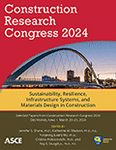Adoption of Circular Economy Practices in the Built Environment—A Survey of US Construction Industry Stakeholders
Publication: Construction Research Congress 2024
ABSTRACT
Millions of tons of construction and demolition waste are sent to landfill sites each year. The circular economy (CE) production and consumption model aims to reduce waste and extend the usage lives of products and infrastructure. Implementing CE in construction enhances sustainability by reducing resource use. In the past decade, barriers and drivers for CE implementation in construction have been identified. However, their applicability may vary in the US due to cultural differences. There is currently a lack of studies examining the perception of specific barriers and drivers related to CE practices in the US. This study assesses stakeholders’ views on the barriers and drivers within the US construction industry. Data were collected through an online survey completed by 63 CE and sustainability, architecture, engineering, and construction stakeholders. Information was analyzed using the relative importance index and the Kruskal-Wallis test. The study findings highlight the top three barriers hindering CE implementation, which include a lack of experience, unfamiliarity with design and construction techniques, and insufficient performance information on reclaimed construction materials. While the top three drivers that promote CE implementation are environmental sustainability, image enhancement, and gaining a competitive advantage.
Get full access to this article
View all available purchase options and get full access to this chapter.
REFERENCES
Bizon-Górecka, J., and J. Górecki. 2017. “Influence of selected stakeholders of construction investment projects on the course of project.” IOP Conf Ser Mater Sci Eng, 72018. IOP Publishing.
Cheng, E. W. L., H. Li, P. E. D. Love, and Z. Irani. 2001. “Network communication in the construction industry.” Corporate Communications: An International Journal. MCB UP Ltd.
Dupont-Inglis, J. 2015. “Circular economy: all eyes on the juncker commission’s next move.” Renewable Matter. International magazine on the bioeconomy and the circular economy, 2 (2).
Elisha, O. D. 2020. “Moving Beyond Take-Make-Dispose to Take-Make-Use for Sustainable Economy.” Int. J. Sci. Res. Educ, 13: 497–516.
Ghisellini, P., X. Ji, G. Liu, and S. Ulgiati. 2018. “Evaluating the transition towards cleaner production in the construction and demolition sector of China: A review.” J Clean Prod, 195: 418–434. Elsevier.
Grafström, J., and S. Aasma. 2021. “Breaking circular economy barriers.” J Clean Prod, 292: 126002. Elsevier. https://doi.org/10.1016/J.JCLEPRO.2021.126002.
Gue, I. H. V., M. A. B. Promentilla, R. R. Tan, and A. T. Ubando. 2020. “Sector perception of circular economy driver interrelationships.” J Clean Prod, 276: 123204. Elsevier. https://doi.org/10.1016/J.JCLEPRO.2020.123204.
Guide, A. 2001. Project management body of knowledge (pmbok® guide). Project Management Institute.
Holt, G. D. 2013. “Asking questions, analysing answers: Relative importance revisited.” Construction Innovation, 14 (1): 2–16. Emerald Group Publishing Limited. https://doi.org/10.1108/CI-06-2012-0035/FULL/XML.
Hossain, M. U., S. T. Ng, P. Antwi-Afari, and B. Amor. 2020. “Circular economy and the construction industry: Existing trends, challenges and prospective framework for sustainable construction.” Renewable and Sustainable Energy Reviews, 130: 109948. Elsevier.
Kirchherr, J., L. Piscicelli, R. Bour, E. Kostense-Smit, J. Muller, A. Huibrechtse-Truijens, and M. Hekkert. 2018a. “Barriers to the Circular Economy: Evidence From the European Union (EU).” Ecological Economics, 150: 264–272. Elsevier. https://doi.org/10.1016/J.ECOLECON.2018.04.028.
Kirchherr, J., L. Piscicelli, R. Bour, E. Kostense-Smit, J. Muller, A. Huibrechtse-Truijens, and M. Hekkert. 2018b. “Barriers to the Circular Economy: Evidence From the European Union (EU).” Ecological Economics, 150: 264–272. Elsevier. https://doi.org/10.1016/J.ECOLECON.2018.04.028.
Kumar, V., I. Sezersan, J. A. Garza-Reyes, E. D. R. S. Gonzalez, and M. A. Al-Shboul. 2019. “Circular economy in the manufacturing sector: benefits, opportunities and barriers.” Management Decision, 57 (4): 1067–1086. Emerald Group Holdings Ltd. https://doi.org/10.1108/MD-09-2018-1070/FULL/XML.
Leighton, K., S. Kardong-Edgren, T. Schneidereith, and C. Foisy-Doll. 2021. “Using Social Media and Snowball Sampling as an Alternative Recruitment Strategy for Research.” Clin Simul Nurs, 55: 37–42. Elsevier. https://doi.org/10.1016/J.ECNS.2021.03.006.
McKight, P. E., and J. Najab. 2010. “Kruskal-Wallis Test.” The Corsini Encyclopedia of Psychology, 1–1. John Wiley & Sons, Ltd. https://doi.org/10.1002/9780470479216.CORPSY0491.
Nemoto, T., and D. Beglar. n.d. Developing Likert-Scale Questionnaires Campus Reference Data.
Nipa, T. J., S. Kermanshachi, and S. Kamalirad. 2019. Development of Effective Communication Framework Using Confirmatory Factor Analysis Technique, Computing in Civil Engineering 2019: Data, Sensing, and Analytics. American Society of Civil Engineers Reston.
“Recycling-circular-economy-diagram - Joslyn Institute for Sustainable Communities.” n.d. Accessed October 27, 2022. https://joslyninstitute.org/initiatives/sustainability-leadership-presentation-series-slps/recycling-circular-economy-diagram/.
Rios, F. C., D. Grau, and M. Bilec. of Construction Engineering, and Undefined. 2021. 2021. Barriers and enablers to circular building design in the US: an empirical study. ascelibrary.org. https://doi.org/10.1061/(ASCE)CO.1943-7862.0002109.
Rizos, V., et al. 2016. “Implementation of Circular Economy Business Models by Small and Medium-Sized Enterprises (SMEs): Barriers and Enablers.” Sustainability 2016, Vol. 8, Page 1212, 8 (11): 1212. Multidisciplinary Digital Publishing Institute. https://doi.org/10.3390/SU8111212.
Safapour, E., S. Kermanshachi, S. Kamalirad, and D. Tran. 2019. “Identifying Effective Project-Based Communication Indicators within Primary and Secondary Stakeholders in Construction Projects.” Journal of Legal Affairs and Dispute Resolution in Engineering and Construction, 11 (4): 04519028. American Society of Civil Engineers. https://doi.org/10.1061/(ASCE)LA.1943-4170.0000332.
Safapour, E., S. Kermanshachi, and I. Ramaji. 2018. “Entity-based investigation of project complexity impact on size and frequency of construction phase change orders.” Proceedings of Construction Research Congress, 2–4.
“Sustainable Management of Construction and Demolition Materials | US EPA.” n.d. Accessed November 22, 2022. https://www.epa.gov/smm/sustainable-management-construction-and-demolition-materials.
Zhijun, F., and Y. Nailing. 2007. “Putting a circular economy into practice in China.” Sustain Sci, 2 (1): 95–101. Springer.
Information & Authors
Information
Published In
History
Published online: Mar 18, 2024
Authors
Metrics & Citations
Metrics
Citations
Download citation
If you have the appropriate software installed, you can download article citation data to the citation manager of your choice. Simply select your manager software from the list below and click Download.
